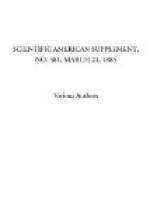[Illustration: 12e: FIG. 5.—Boghead from New South Wales, X500.]
From what precedes it seems to result, then, that anthracite is in a much less appreciable state of preservation than cannel coal, and that it is only rarely, and according to locality, that we can discover vegetable organs in it. Soft coal comes nearer to amorphous carbon. Boghead appears to be of an entirely different character (Fig. 5, magnified X300). It is easily reduced to a thin transparent plate, and shows itself to be formed of a multitude of very small lenses, differing in size and shape, and much more transparent than the bands that separate them. In the interior of these lenses we distinguish very fine lines radiating from the center and afterward branching several times. The ramifications are lost in the periphery amid fine granulations that resemble spores. We might say that we here had to do with numerous mycelia moulded in a slightly colored resin. Preparations made from New South Wales and Autun boghead presented the same aspect.
If boghead was derived from the carbonization of parts that were soluble, or that became so through maceration, and were made insoluble at a given moment by carbonization, we can understand the very peculiar aspect that this combustible presents when it is seen under the microscope.
The following figures were made in order to show the details of anatomical structure that are still visible in coal, and to permit of estimating the shrinkage that the organic substance has undergone in becoming converted into coal.
It is not rare in coal mines to find fragments of wood, of which a portion has been preserved by carbonates of iron and lime, and another portion converted into coal. This being the case, it was considered of interest to ascertain whether the carbonized portion had preserved a structure that was still recognizable, and, in such an event, to compare this structure with that of the portion of the specimen that was preserved in all its details by mineralization.
[Illustration: 12f: FIG. 6.—Arthropitus gallica, St. Etienne; transverse section, X200.]
Fig. 6 shows a transverse section of a specimen of Arthropitus Gallica found under such conditions. The region marked c is carbonized; the organic elements of the wood-cells, tracheae, etc., have undergone but little change in shape. Moreover, no change at all exists in the internal parts of another specimen (Fig. 8), where we easily distinguish by their form and dimensions the ligneous cells, aa, and the elements, bb, of the wood itself.
[Illustration: 12h: FIG. 8.—Arthropitus gallica, St. Etienne; transverse section through the carbonized part.]




